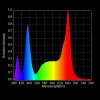I'm not an LED salesman, so I'm not trying to convince anyone to make the switch. If you can make use of the additional heat, then HID is probably right for you.
Let's crunch some numbers just for the hell of it...
Let's say a 300 watt LED is roughly the equivalent (in light output) of a 600 watt HID, but used 1/2 the electricity. Let's also say that the LEDs will last 30,000 hours (even though i have seen ratings from 50,000 to 100,000 hours)
Running 12/12 cycles for 9 weeks is about 750 hours. 30,000 / 750 = 40, so you should see 40 harvests out of the LEDs. If you run 5 crops a year, this would be 8 years.
300 watts for 30,000 hours is 9,000 kwh. Energy cost would depend on your local rates...
9.000 kwh @ .10 = $ 900
9.000 kwh @ .1258 = $1,132 (US National Average)
9.000 kwh @ .15 = $1,350
9.000 kwh @ .20 = $1,800
Since a 600 watt HID fixture would consume twice the energy over the same period of time, we can see that the energy cost of running LEDs is equal to the savings. For example, if you pay 15 cents per kwh, a 300 watt LED will cost $1,350 less to run over its life. This difference alone more than offsets the higher up front cost.
So the cost of a 600 watt HID fixture (looked at over 8 years) is the original cost of the fixture, plus its energy usage, plus a replacement bulb a year, plus at least one replacement ballast.
Or roughly...
Cost of hood, ballast, light $ 200
Energy @ .15/kwh 2,700
1 replacement bulb/year 350 (7 x $50)
1 replacement ballast 75
total $ 3325
And the cost of the LED...
Initial cost of fixture $ 900 (300 "wall watt" HydroGrow Sol 6)
Energy @ .15/kwh 1,350
total $2,250
Unless I am missing something? If I'm wrong, I would appreciate someone taking the time to help me get my head out of my ass. Thanks!



